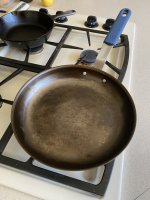There are dozens of different common steel alloys, and hundreds of uncommon ones.
The very word 'steel' is a broad catch all that encompasses any alloy with iron and carbon in it, as long as there's not too little carbon (in which case it's usually called 'iron'; Or too much, in which case it's usually called 'cast iron').
'Stainless steel' is likewise a moveable feast; Typically it's defined by its Chromium content, and many Stainless Steels contain significant Nickel and Molybdenum. There are five different classes of Stainless steels, based on the microscopic crystalline structure which defines the broad tempering, work-hardening, and ferromagnetic properties of the final product; And each class contains a large number of different alloys, with different detailed behaviours.
The problem is that steel working is ancient. And two millennia ago, there were no intellectual property laws; So metal workers used security by obscurity, and deliberately set out to name their products in a way that was as confusing as possible to anyone not steeped in the cant of their specific little area of expertise.
Marketers continued this trend, and the whole mess is impenetrable to anyone who's not prepared to spend years learning about the context dependent names of huge numbers of alloys.
'Carbon Steel' may or may not have a specific and precise meaning, when applied to cookware. If it does, it probably has a different (but likely also specific and precise) meaning in other contexts.
And just in case we weren't sufficiently confused, these terms probably have different (but specific and precise) meanings in different regions and countries. Various attempts have been made to rationalise these specifications, such as the AISI three digit numbering system, and the SAE four digit numbering system, which were merged in the late 20th Century; However European and Chinese specifications disagree (but with considerable overlap) on which alloys belong in the 'Stainless steel' category, and which in 'Carbon steel'.
It's therefore quite possible that the same wok is made of stainless steel until you carry it across a national border, at which point it would become fraud to sell it as 'stainless steel', because it's now 'carbon steel'.
Regardless of what you call it, uncoated steel or iron cookware will generally benefit from seasoning with hot oil; And ideally you should use an oil with a low flavour profile and a high smoke point, such as peanut oil or lard.
As a truly crude rule of thumb, cast iron shatters if struck, carbon steel dents if struck, and stainless steel dents but also cracks if struck. Carbon steel pans are, as a result, typically very thin, stainless steel somewhat thicker to avoid cracking, and cast iron thicker still. Thicker implies heavier, but also implies slower and more even heating and cooling. Which is best depends on both your cooking style, and your personal taste. All three will rust if not seasoned, but stainless generally doesn't rust noticeably unless badly mistreated, while the others really do need proper seasoning to avoid corrosion issues. Cast iron is particularly porous, and should never be washed using detergent, which strips out the seasoning.


